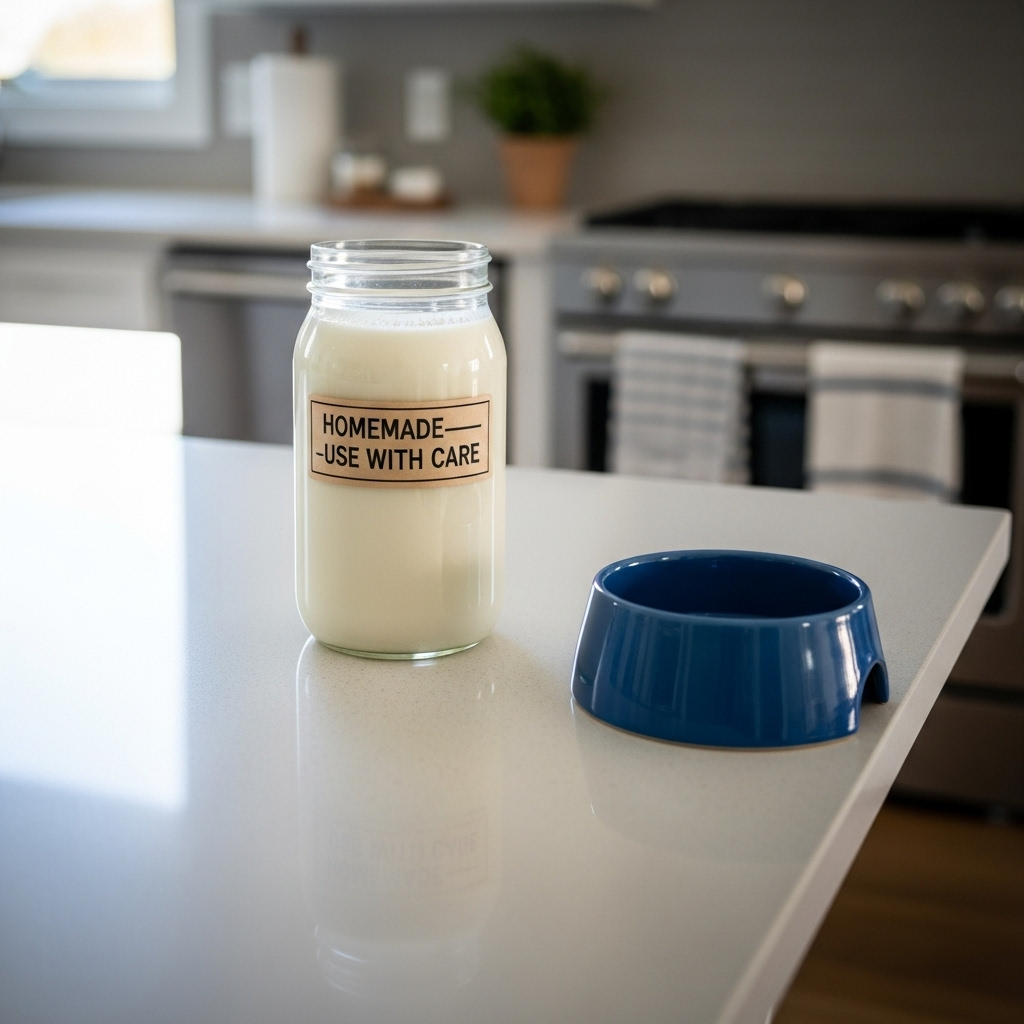Homemade Kefir for Dogs: Probiotic Safety Guidelines

Many pet owners are interested in giving dogs probiotic foods such as kefir to support gut health. Homemade kefir can be a convenient, low-cost source of beneficial bacteria and yeasts, but it must be made and served safely. This guide explains how to prepare, introduce and store homemade milk kefir for dogs, appropriate serving sizes, risks to watch for, and when to consult your veterinarian.
What is kefir and why people consider it for dogs?
Kefir is a fermented milk drink produced by fermenting milk with kefir grains (a symbiotic culture of bacteria and yeasts). The resulting product contains a variety of live microorganisms — commonly Lactobacillus, Lactococcus, Leuconostoc, Bifidobacterium species and some yeasts — plus lactic acid, vitamins and peptides. Pet owners use small amounts of kefir to introduce live cultures that may support digestion and maintain a healthy microbial balance in the gut. While many dogs tolerate small servings well, kefir is not a medicine and results vary by animal.
Basic safety principles before you start
- Talk with your veterinarian first, especially if your dog is young, elderly, pregnant, nursing, immunocompromised or has chronic illness (e.g., diabetes, pancreatitis, inflammatory bowel disease).
- Use clean equipment and food-safe practices to reduce contamination risk.
- Prefer pasteurized milk over raw milk to minimize pathogen exposure. Raw milk can contain harmful bacteria even before fermentation.
- Introduce gradually and monitor for any adverse reactions (vomiting, diarrhea, lethargy, skin changes).
- Avoid flavored kefir, added sugars, artificial sweeteners (xylitol is toxic to dogs) or other additives.
How to make simple milk kefir for dogs (summary)
Ingredients and equipment
- Pasteurized whole, low-fat, or goat milk (cow or goat milk are most common)
- Kefir grains or a freeze-dried kefir starter labeled for milk
- Clean glass jar with breathable cover (coffee filter or cloth secured with a band)
- Plastic or wooden strainer and spoon (avoid reactive metal contact with grains)
Basic steps
- Add about 1 tablespoon of kefir grains per 1–2 cups (250–500 ml) of milk. If using a powdered starter, follow package directions.
- Cover the jar with a breathable lid and leave at room temperature (68–78°F / 20–26°C) out of direct sunlight.
- Ferment 12–48 hours. Shorter time yields milder kefir; ~24 hours is common. Stop fermentation when the milk thickens and has a slightly tart smell.
- Strain out grains using a clean plastic/nylon strainer. Grains are reusable; store them in a small jar of fresh milk in the fridge if not immediately reused.
- Refrigerate strained kefir and use within about 7–10 days. Smell and appearance should remain normal (no mold, pink/orange tint, or strong off odors).
Serving sizes and how to introduce kefir
Start very small and increase slowly over several days to a week. This reduces the chance of gastrointestinal upset as the gut adjusts to new cultures.
- Tiny dogs (<10 lb / <4.5 kg): start with 1/4 to 1/2 teaspoon once daily.
- Small dogs (10–25 lb / 4.5–11 kg): start with 1/2 to 1 teaspoon.
- Medium dogs (25–50 lb / 11–23 kg): start with 1–2 teaspoons.
- Large dogs (50–100 lb / 23–45 kg): start with 1–2 tablespoons.
- Giant breeds (>100 lb / >45 kg): start with 2–3 tablespoons.
After a week without adverse signs, you can use kefir a few times per week or daily at these small amounts. Many owners use kefir as a topper on food rather than a full meal replacement.
Special considerations and precautions
Raw milk vs. pasteurized
Raw milk carries a higher risk of pathogenic bacteria. If you choose raw milk, be aware of the risk and discuss with your veterinarian. Pasteurized milk reduces that risk and is the safer starting point for homemade kefir intended for pets.
Dogs on antibiotics, immunocompromised pets, puppies, pregnant or elderly dogs
– Dogs on antibiotics: probiotics can be helpful, but give kefir at a different time of day than the antibiotic dose; discuss with your veterinarian.
– Immunocompromised, very young (under 8–12 weeks) or severely ill pets: avoid giving live-culture foods without veterinary approval because of infection risk.
– Pregnant/nursing/elderly dogs: consult your vet before starting kefir.
Spoilage signs to watch for
Discard kefir if you see visible mold (fuzzy or colored growth), pink/orange tint, sliminess, or a foul smell. Normal kefir smells tangy or yeasty and may separate (whey on top) — gently stir or strain before serving.
Pros and cons
| Pros | Cons / Risks |
|---|---|
| May introduce beneficial bacteria and yeasts for digestion | Possible GI upset if introduced too quickly |
| Easy and inexpensive to make at home | Contamination risk if poor hygiene or use of raw milk |
| Versatile—small amounts are well accepted by many dogs | Not suitable for immunocompromised or very young animals without vet approval |
FAQ
1. Can every dog have kefir?
Not every dog should have kefir. Healthy adult dogs often tolerate small amounts, but puppies, immunocompromised, very ill, or dogs with certain conditions should only receive kefir under veterinary advice.
2. Is store-bought kefir safer than homemade?
Store-bought pasteurized kefir made for human consumption is generally produced under controlled conditions and can be a safer option than homemade kefir if you are unsure about your hygiene or fermentation process. Still avoid flavored varieties with added sugars or artificial sweeteners.
3. My dog had diarrhea after kefir — what should I do?
Stop kefir immediately and monitor. If diarrhea is mild and resolves quickly, it may have been an adjustment. If diarrhea is severe, prolonged, bloody, or accompanied by vomiting or lethargy, contact your veterinarian right away.
4. Can I use non-dairy kefir for my dog?
Water kefir or coconut milk kefir have different microbial profiles and may be lower in nutrients. Some dogs tolerate them, but they can contain added sugars or coconut fats. Use caution and consult your vet before offering non-dairy kefir regularly.
Key takeaways
- Start with pasteurized milk and clean equipment; avoid raw milk unless advised by your vet.
- Introduce kefir slowly in very small amounts and monitor your dog for adverse reactions.
- Prefer store-bought pasteurized kefir if you are inexperienced with fermentation or have a high-risk pet.
- Do not use flavored, sweetened, or xylitol-containing products; keep servings modest and infrequent.
- Consult your veterinarian before giving kefir to puppies, elderly, pregnant, nursing, immunocompromised, or medically fragile dogs.
Note: This information is educational and not a substitute for professional veterinary care. If your dog has a medical condition or you are unsure about introducing kefir, contact your veterinarian.
Disclaimer: The information in this article is intended for general guidance only. It does not replace individualized advice from a licensed veterinarian. Always consult your veterinarian before introducing new foods or supplements to your pet’s diet, especially if your pet has underlying health issues or is taking medications.

Leave a Reply